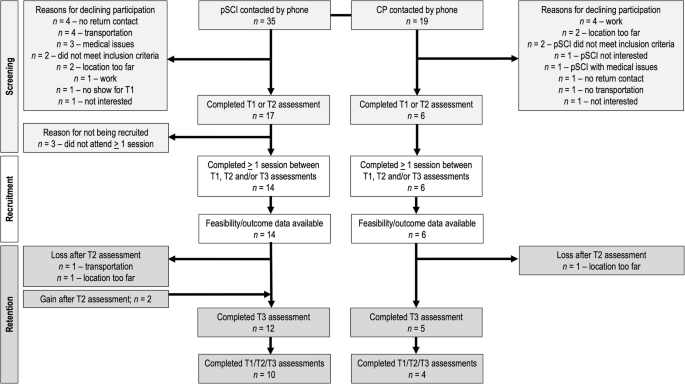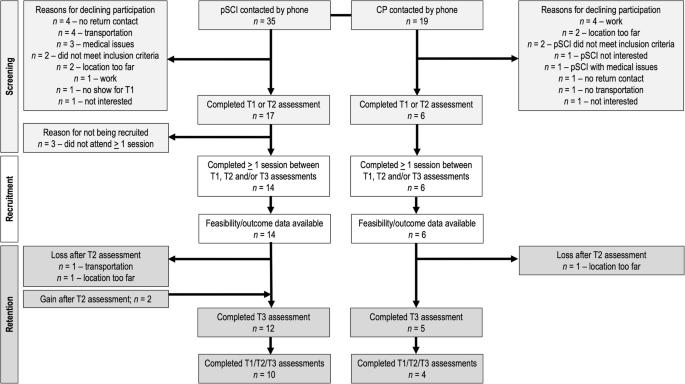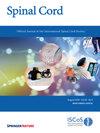为脊髓损伤患者及其护理伙伴提供高强度功能训练。
IF 2.2
4区 医学
Q3 CLINICAL NEUROLOGY
引用次数: 0
摘要
研究设计非随机临床试验:研究脊髓损伤患者(pSCI)及其护理伙伴(CPs)高强度功能训练(HIFT)运动项目的可行性、对身体和心理的影响:方法:采用单组设计,在三个评估点(计划前、计划中期(13 周)和计划后(25 周))检查 25 周内多达 49 节 HIFT 课程的效果。课程持续时间为 60 到 75 分钟,并根据参与者的能力进行调整。可行性测量包括招募、保留、出勤率、安全性和忠实性(通过会话-感知用力评分(RPE)评定运动强度)。体能测量包括心血管耐力、有氧运动能力和肌肉力量。社会心理测量包括对运动的社会支持感知、运动自我效能和与健康相关的生活质量:共纳入 14 名截瘫患者(7 名截瘫患者和 7 名四肢瘫痪患者,2 名女性)和 6 名 CPs(4 名女性)(中位年龄 = 60)(IQR = 15.8)。颅内压增高症患者的招募率为 40%,颅内压增高症患者的招募率为 32%。参与者平均参加了 73% (22%) 的锻炼课程,课程 RPE 中位数为 5(IQR = 1)。pSCI 和 CP 的保留率分别为 83% 和 67%。对于 pSCI 及其 CPs,在心血管耐力、无氧运动能力、肌肉力量和对运动的社会支持方面观察到了较大的效应大小:对于 pSCI 及其 CPs,HIFT 似乎是可行的,并有可能改善这两个群体的身体和社会心理健康。本文章由计算机程序翻译,如有差异,请以英文原文为准。


High intensity functional training for people with spinal cord injury & their care partners
Non-randomized clinical trial. Examine the feasibility, physical and psychosocial effects of a high intensity functional training (HIFT) exercise program for people with spinal cord injury (pSCI) and their care partners (CPs). Community fitness center in a Medically Underserved Area (Fort Smith, USA.) A single-group design with three assessment points (before the program, at midpoint (13 weeks), and post-program (25 weeks) was used to examine the effects of up to 49 HIFT sessions over 25-weeks. Sessions were 60 to 75 min in duration and adapted to the abilities of participants. Feasibility measures included recruitment, retention, attendance, safety and fidelity (exercise intensity rated via session-Rating of Perceived Exertion (RPE). Physical measures included cardiovascular endurance, anaerobic power, and muscular strength. Psychosocial measures included perceived social support for exercise, exercise self-efficacy and health-related quality of life. Fourteen pSCI (7 with paraplegia and 7 with tetraplegia, 2 females) and 6 CPs (4 females) were included (median age = 60) (IQR = 15.8). Recruitment rates were 40% for pSCI and 32% for CPs. On average, participants attended 73% (22%) of exercise sessions with a median session-RPE of 5 (IQR = 1). Retention rates were 83% and 67% for pSCI and CPs, respectively. For pSCI and their CPs, large effect sizes were observed for cardiovascular endurance, anaerobic power, muscular strength, and social support for exercise. For pSCI and their CPs, HIFT appears feasible and potentially leads to improvements in physical and psychosocial health for both groups.
求助全文
通过发布文献求助,成功后即可免费获取论文全文。
去求助
来源期刊

Spinal cord
医学-临床神经学
CiteScore
4.50
自引率
9.10%
发文量
142
审稿时长
2 months
期刊介绍:
Spinal Cord is a specialised, international journal that has been publishing spinal cord related manuscripts since 1963. It appears monthly, online and in print, and accepts contributions on spinal cord anatomy, physiology, management of injury and disease, and the quality of life and life circumstances of people with a spinal cord injury. Spinal Cord is multi-disciplinary and publishes contributions across the entire spectrum of research ranging from basic science to applied clinical research. It focuses on high quality original research, systematic reviews and narrative reviews.
Spinal Cord''s sister journal Spinal Cord Series and Cases: Clinical Management in Spinal Cord Disorders publishes high quality case reports, small case series, pilot and retrospective studies perspectives, Pulse survey articles, Point-couterpoint articles, correspondences and book reviews. It specialises in material that addresses all aspects of life for persons with spinal cord injuries or disorders. For more information, please see the aims and scope of Spinal Cord Series and Cases.
 求助内容:
求助内容: 应助结果提醒方式:
应助结果提醒方式:


